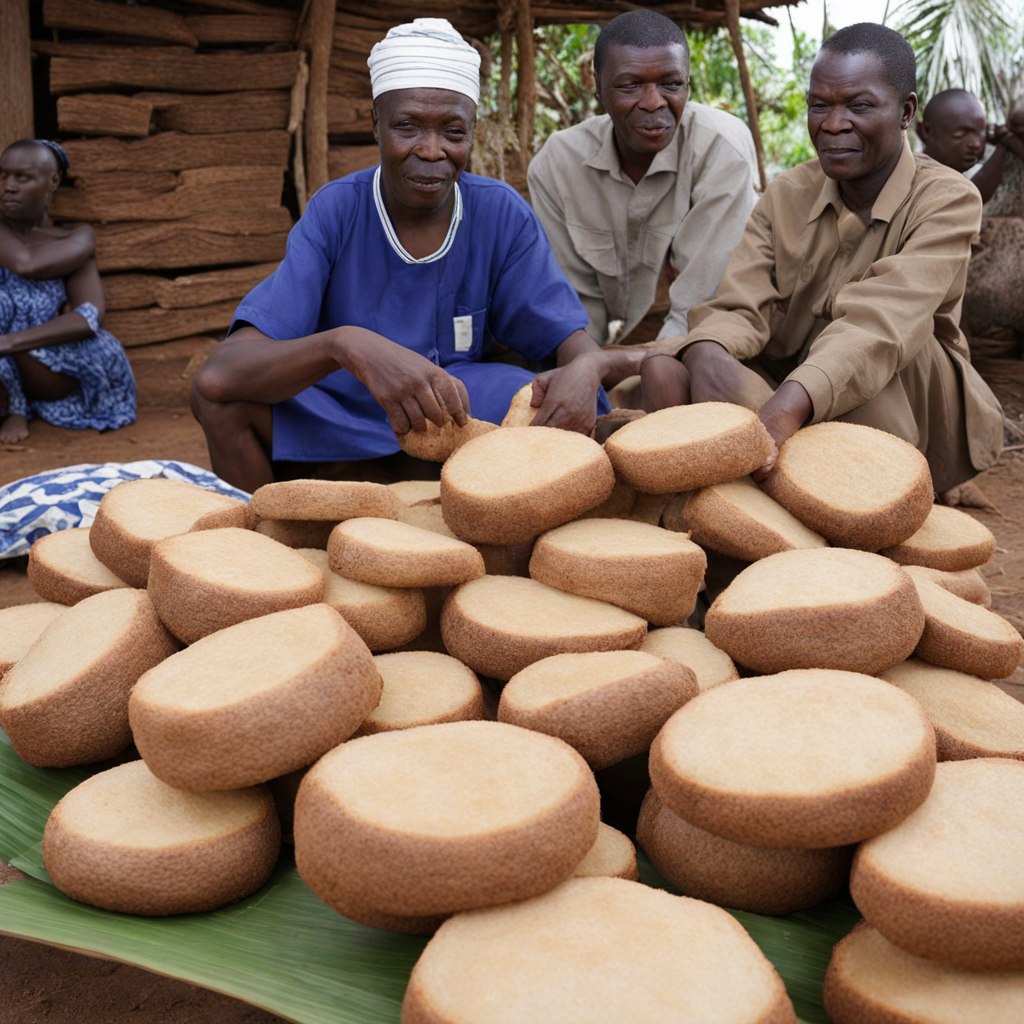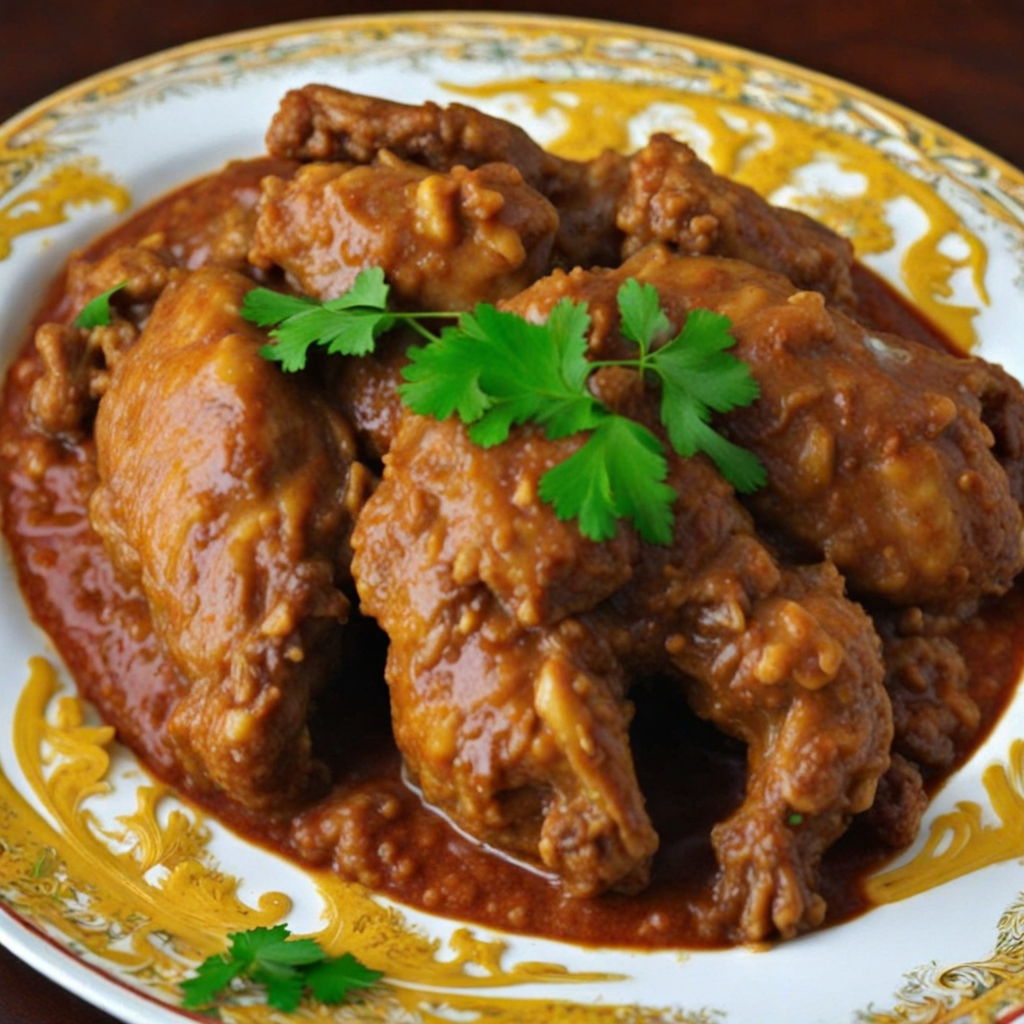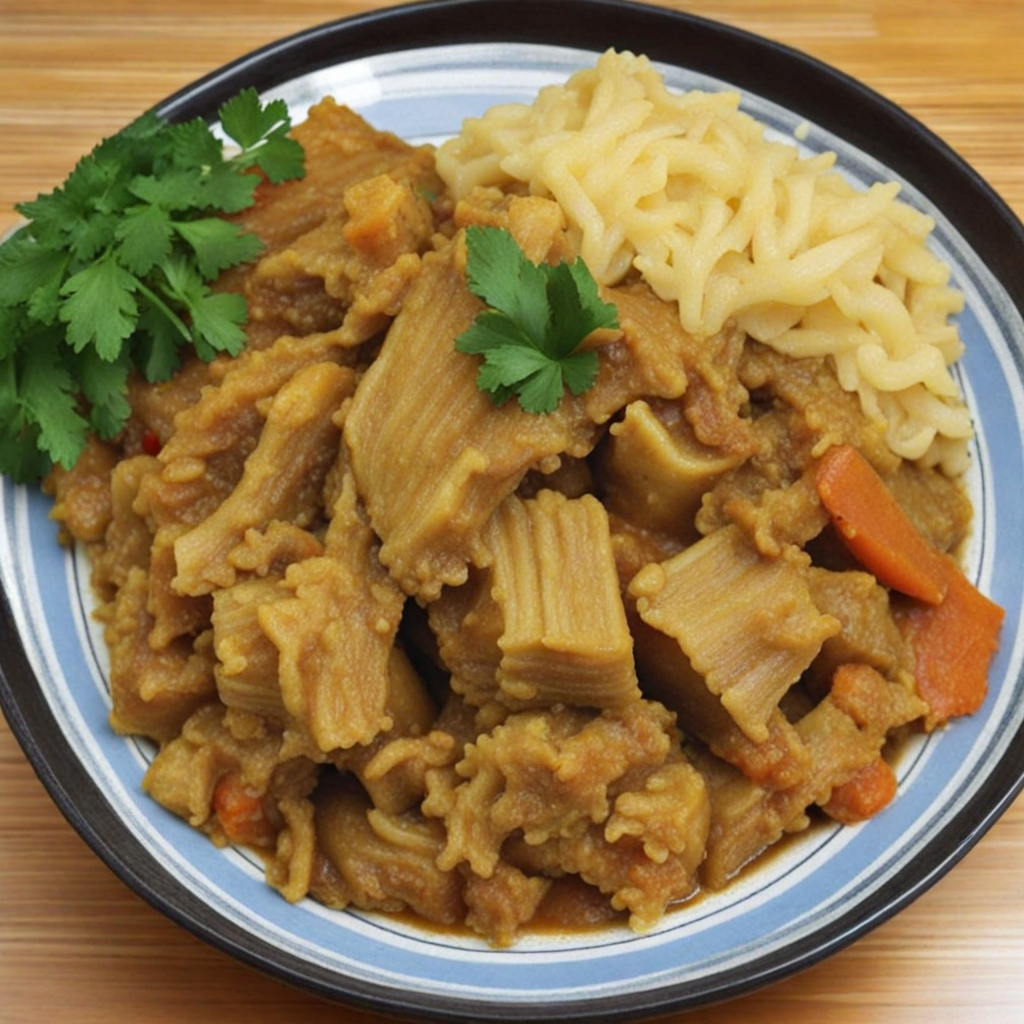Kwanga
Kwanga, a staple food from the Democratic Republic of Congo, is a unique and flavorful dish that embodies the rich culinary traditions of the region. Made from cassava, a root vegetable that is widely cultivated in tropical climates, Kwanga is prepared by fermenting and then steaming the cassava into a dough-like consistency. The result is a dense, elastic texture that can be sliced into rounds or served in larger portions. Its neutral flavor serves as a perfect canvas for a variety of accompanying sauces and dishes, allowing it to complement an array of flavors from spicy stews to savory soups. The preparation of Kwanga is a communal affair, often involving family and friends as they gather to transform the raw cassava into this beloved food. The fermentation process not only enhances the taste but also preserves the cassava, making it a practical choice for sustenance. Once steamed, Kwanga is often wrapped in banana leaves, adding a subtle earthiness to its flavor and aroma. This traditional method of preparation not only honors the heritage of Congolese cuisine but also contributes to the dish's distinct character. When served, Kwanga can be enjoyed in numerous ways. It is commonly paired with rich and hearty sauces made from ingredients like peanuts, palm oil, and various meats or vegetables, creating a delightful contrast of textures and flavors. The dish is often accompanied by stews such as moambe, which features chicken or fish cooked in a spicy palm nut sauce. Kwanga’s versatility, combined with the communal experience of its preparation and consumption, makes it a true culinary gem that invites food lovers to explore the vibrant tastes of Congolese cuisine.
How It Became This Dish
Kwanga: The Heart of Congolese Culinary Tradition Kwanga, a staple food in the Democratic Republic of the Congo (DRC), is a versatile form of cassava bread that has played a crucial role in the lives of Congolese people for centuries. Its history is deeply intertwined with the agricultural practices, cultural significance, and social customs of the region, making it not just a food item but a symbol of resilience and community. Origins The origins of kwanga can be traced back to the indigenous peoples of Central Africa, who have cultivated cassava (Manihot esculenta) for millennia. Cassava is a drought-resistant crop that thrives in the tropical climate of the region, making it an essential source of carbohydrates for many communities. It is believed that cassava was introduced to Africa from Brazil in the 16th century, brought by Portuguese traders. Over time, it became a vital crop across West and Central Africa, including the Congo basin. Kwanga is made by fermenting and processing cassava roots into a starchy dough, which is then wrapped in leaves and cooked. The traditional preparation methods vary among different ethnic groups, but the basic principles remain consistent: drying, grating, fermenting, and cooking the cassava. This labor-intensive process is not merely about sustenance; it is an integral part of the social fabric, often involving communal effort and shared knowledge passed down through generations. Cultural Significance Kwanga is more than just a food item in Congolese culture; it represents identity, heritage, and community. Traditionally, it is consumed at every meal and accompanies a wide variety of dishes, ranging from vegetable stews to meats and fish. The significance of kwanga can be seen in various cultural practices, rituals, and gatherings. In many Congolese communities, the preparation of kwanga is a communal affair. Women often gather to process cassava and prepare kwanga, reinforcing social bonds and fostering a sense of community. This practice highlights the essential role of women in agricultural production and food preparation, showcasing their contributions to family and societal well-being. During festivals and significant life events—such as weddings, births, and funerals—kwanga is often a central dish, symbolizing abundance and hospitality. It is not uncommon for families to prepare large quantities of kwanga to share with neighbors and visitors, emphasizing the importance of generosity and communal sharing in Congolese culture. Additionally, kwanga's versatility and adaptability have allowed it to take on various forms, reflecting the diversity of Congolese cuisine across different regions. In some areas, kwanga is known as "fufu" or "ubwoko," with slight variations in preparation and texture. The differences in nomenclature and method highlight the rich tapestry of cultural influences and traditions within the DRC. Development Over Time The history of kwanga is also reflective of the socio-political changes that have affected the DRC over time. The country has experienced significant upheaval, from colonial rule to post-independence struggles, and these events have shaped agricultural practices and food availability. During colonial times, the forced labor imposed by European colonizers disrupted traditional farming methods and led to food shortages. Despite these challenges, kwanga remained a staple, serving as a source of nourishment and resilience for local populations. In recent decades, the DRC has faced ongoing conflicts and economic difficulties, which have impacted agricultural practices and food security. The rise of urbanization has led to changes in food consumption patterns, with many people moving to cities and adopting more Westernized diets. Nonetheless, kwanga has retained its status as a cherished food, often found in urban markets and households, and is still a favorite among the Congolese diaspora around the world. The globalization of cuisine has also influenced the way kwanga is perceived and consumed. As Congolese communities spread across the globe, kwanga has become a culinary ambassador, introducing people to Congolese culture and traditions. Restaurants featuring Congolese cuisine have emerged in various cities, showcasing kwanga alongside other traditional dishes. This exposure has not only allowed for the preservation of culinary traditions but has also fostered cultural exchange, where kwanga is appreciated by diverse audiences. Conclusion Kwanga is more than just a food; it is a symbol of the Congolese way of life, embodying the resilience, community, and cultural richness of the people of the DRC. Its historical roots in the cultivation of cassava, combined with its role in communal practices and social gatherings, make it an essential element of Congolese identity. As the DRC continues to navigate its complex socio-political landscape, kwanga remains a steadfast reminder of the strength and unity of its people. In a world increasingly influenced by globalization, the enduring legacy of kwanga serves as a testament to the importance of preserving culinary traditions and celebrating cultural heritage. Whether enjoyed at a family meal or a communal gathering, kwanga continues to nourish not just the body but also the spirit of Congolese culture, embodying the values of community, resilience, and shared history. As we explore the rich tapestry of global cuisines, kwanga stands out as a poignant reminder of the stories and traditions that shape our culinary experiences, inviting us to appreciate the connections we share through food.
You may like
Discover local flavors from Congo







